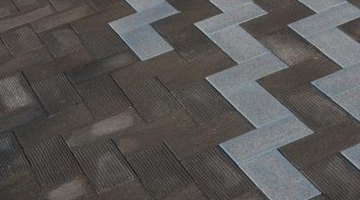How to Install Ceramic Tile Over an Expansion Joint
When installing ceramic tile onto a concrete surface, you must make allowances for the movement in the concrete because of temperature changes. Without the addition of expansion joints cut throughout the slab, the seasonal expansion and contraction of the concrete causes cracks to form over the concrete surface. The inclusion of the joints allows the slab to move in sections instead, decreasing the stress throughout the material. Placing a ceramic tile over an expansion joint transfers the slab's movement into the tile, eventually causing the tile to crack. Preventing these cracks requires that you work with the expansion joints, incorporating them into your tile installation pattern.

-
Clean out the expansion joint with a nylon brush, removing any dirt or debris. Wash the surface of the concrete with a pH-neutral cleanser and rinse with water. Allow the surface to dry before beginning tile installation. Measure the length of the joint across the surface with a measuring tape and divide this length by half, placing a mark on the surface with a piece of chalk at the center point along the joint.
-
Mix a batch of thinset mortar in a large bucket, using an electric drill with paddle drill bit attachment.
-
Spread the mortar on the floor, using a notched trowel along the edge of the expansion joint at the joint's center. Lay enough of the adhesive to attach about five tiles in a row. Tilt the trowel onto its edge and run the notches along the mortar, raising ridges in the adhesive for a more even grip on the rear of the tiles.
-
Place the five tiles in the row, beginning with a tile centered on your chalk mark. Use a slight twisting motion to set the tiles in place. Put two tile spacers against the tile edges separating adjoining tiles to create uniform spaces between the tiles. Continue placing the tiles on the surface, working outward toward the edge until you've completed the first row with all of the full-sized you're able to place.
-
Remove any excess mortar from the expansion joint in the surface with the edge of the trowel, leaving the joint clear.
-
Continue building on the tile row, using spacers to separate each new row from the last, and filling the tiled surface to the edge.
-
Repeat the process from the other side of the expansion joint, keeping the joint clear of all materials. Measure the spaces left on the edge of the tiling surface for partial tiles. Cut the partial tiles to size, using the tile cutter, and place them onto the surface with the mortar.
-
Place a carpenter's level across adjoining tiles to test the level. Adjust the tiles as needed while the mortar remains wet by tapping high tiles into place with a rubber-headed mallet, or adding more mortar to the bottom of low tiles, until the entire surface is leveled. Wait 24 hours for the mortar holding the tile to set.
-
Mix the grout in a bucket with the drill and paddle bit until attaining the consistency of peanut butter. Remove the tile spacers and apply grout to the joints between all the tiles except for the joint over the expansion joint or joints adjoining any moisture-rich surfaces such as sinks or bathtubs. Place the grout onto the tile surfaces and spread the grout into the joints, using a grout float to push the grout into place.
-
Remove excess grout from the surface of the tiles, using a damp sponge within 15 minutes of grout placement. Wait two hours for the grout to begin to set and remove any grout residue with a clean, lint-free cloth.
-
Fill the tile joint above the expansion joint with polyurethane caulk. Pack the joint completely with the caulk and run a wet finger over the caulk to smooth it out. Remove any excess caulk on the tile with a rag. Fill the joints near the wet surfaces with a silicone caulk to protect against moisture leaking beneath the tiles. Allow the grout to dry for 10 days.
-
Brush the surface of the grout with a tile and grout sealant to protect against moisture damage and staining. Allow the sealant to dry for 48 hours before using the surface.
References
Resources
Writer Bio
Larry Simmons is a freelance writer and expert in the fusion of computer technology and business. He has a B.S. in economics, an M.S. in information systems, an M.S. in communications technology, as well as significant work towards an M.B.A. in finance. He's published several hundred articles with Demand Studios.
Photo Credits
- Jupiterimages/Photos.com/Getty Images
More Articles



